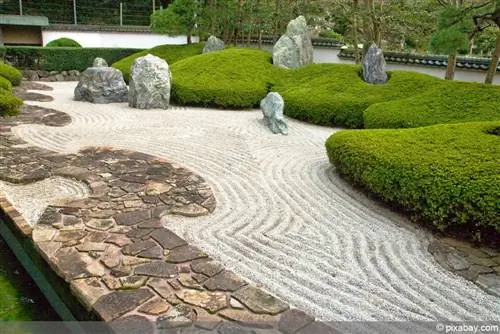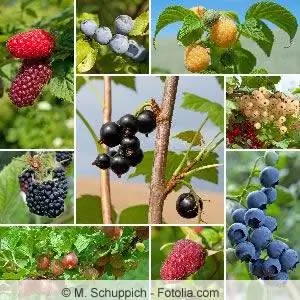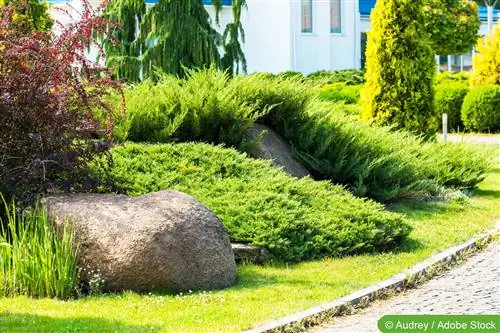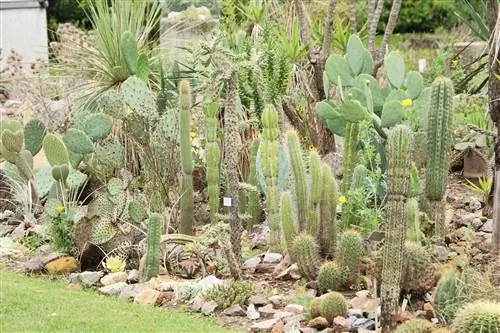- Author admin [email protected].
- Public 2023-12-17 03:39.
- Last modified 2025-06-01 06:48.
What is the secret to a magnificently blooming flower garden, whose floral symphony sounds every season? Distinctive spring bloomers pass the floral baton to boastful summer flowers. In autumn, flower beauties reign supreme with warm colors that last until the first frost. Hardy winter bloomers overcome the challenges of frost and snow. These 5 tips for beginners reveal how to create the perfect flower garden and design it with stylish planting ideas.
Design Garden Theme
It shows a sophisticated sense of style when you design your flower paradise according to a harmonious motto. Recognized high priests of tasteful garden architecture advocate a harmonious unity between building and bed design. Even a beginner can do this if the architectural style of the house is reflected in the plant and flower arrangement of the garden. The following variations are very popular in contemporary garden design:
- Traditional house construction and half-timbered style: Cottage garden as an expression of rural connection
- Modern architectural style: Japanese garden, gravel garden in a strictly formal style with spartan plant compositions
- Country house style: Prairie garden, wild perennial garden, cottage garden as a liaison of blooming vegetables and nostalgic flowers
- Tuscany bungalow: Mediterranean garden with floral ambassadors from the Mediterranean
Fulfilled flower dreams are closely linked to light and temperature conditions, wind exposure and soil quality. The local conditions have the final say on a motto. A location in full sun with sandy, dry soil is ideal for a prairie garden or moderate gravel garden, even if a romantic half-timbered house serves as the backdrop. All efforts to create a Mediterranean flower bed will be in vain if the location is on the shady north side of the house. With a pinch of willingness to compromise and creativity, you can eliminate design conflicts, because beautiful, location-appropriate flower species can be found in many garden design styles.
Create plan sketch
With detailed planning, you can bring your theoretical considerations into line. It is advisable to have at least a rough sketch that specifies fundamental components so that smooth planting and care work in the flower garden is possible. There is enough space left for the realization of imaginative planting ideas, which sometimes only take shape as part of the preparatory work. These aspects should be incorporated into a well-informed plan sketch:
- Path concept: functional, wheelbarrow-wide work paths and narrow, curved strolling paths, each with surface
- Seating, lighting, water supply: Locations, draw pipe route
- Beds: Note position, lighting conditions, soil condition, border
- Plant arrangement: Leading perennials (10-15%), companion flowers (30-40%), gap fillers (50-60%)
The plant arrangement in balanced proportions plays a key role if you want to skillfully lay out your flower garden and design it creatively. Leading perennials act as scaffolding and determine the visual axes. This task is performed by majestic flowers, which appear as solitary or small groups and announce the chosen motto. Typical representatives are delphinium (Delphinium), hollyhock (Alcea) and sunflower (Helianthus). A leading flower at its best boasts a height of 120-180 cm and spectacular flower shapes.

In the middle level, accompanying flowers shine that continue and interpret the floral theme. Popular species include cranesbill (Geranium), cockade flower (Gaillardia grandiflora) and bearded iris (Iris barbata). At the feet of leading and accompanying perennials there are gap fillers, either small flowers or flowering ground cover. Beautiful representatives are girl's eye (Coreopsis grandiflora), daisies (Bellis) and periwinkle (Vinca major). The somewhat derogatory term “gap filler” disguises the fact that primarily small and prostrate species create the longed-for opulence in the flower bed.
Planting ideas for beginners
With a concrete planting plan in your pocket, you can keep track of the garden center's dizzying selection. If you are looking for alternatives that match the motto, you will find what you are looking for more quickly, as well-stocked suppliers usually offer comparable plants side by side. For your inspiration, we have concretized three planting ideas, tailored to the most common lighting conditions: full sun, sunny to partial shade and shady.
Mediterranean sea of flowers under full sun
In full sun locations with sandy-gravelly garden soil, drought-tolerant specialists from the Mediterranean are in demand who won't give up even in the blazing summer sun. The best conditions if you, as a beginner, want to create a stylish flower garden with Mediterranean charm. This is how you can do it with 16 plants on 1.5-2 square meters of space:
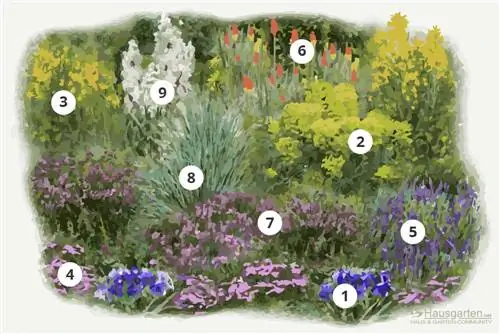
-
Small Iris (Iris Barbata-Nana) - 2 pieces
Growth height 20 cm
Flowering period April to May
-
Mediterranean Spurge (Euphorbia characias) - 1 piece
Growth height 70-80 cm
Flowering period April to May
-
Junker lily (Asphodeline lutea) - 2 pieces
Growth height 60-120 cm
Flowering period May to June
-
Feather carnations (Dianthus pulmarius) - 4 pieces
Growth height 25-30 cm
Flowering period June to August
-
Garden Lavender (Lavandula angustifolia) - 1 piece
Growth height 40-50 cm
Flowering period June and July
-
Torch Lily (Kniphofia uvaria) - 1 piece
Growth height 80-120 cm
Flowering period July to September
-
Flower Dost (Origanum laevigatum) - (3 pieces)
Growth height 25-40 cm
Flowering period July to September
-
Blue oats (Helictotrichon sempervirens) - 1 piece
Growth height 40-100 cm
Flowering period July to September
-
Palm lily (Yucca filamentosa) - 1 piece
Growth height 60-120 cm
Flowering period July and August
The backdrop is formed by junker lilies, torch lilies, palm lilies and blue oats thanks to a growth height of around 100 centimeters. Flower dost, Mediterranean spurge and lavender gather in front of it. In the front row, feather carnations and dwarf irises come into their own.
Sunbed and butterfly pasture
In a sunny to partially shaded location with normal garden soil, the following flowers show their most beautiful side, swarmed by colorful butterflies and other busy insects:
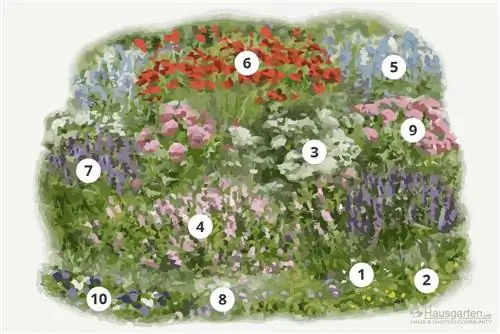
-
Märzenbrecher (Leucojum vernum)
Growth height 20-30 cm
Flowering period February to March
-
Anemone ranunculoidesAnemone ranunculoides
Growth height 20-25 cm
Flowering period March to May
-
White Spur Flower (Centranthus ruber Albus)
Growth height 50-60 cm
Flowering period May to September
-
Shaggy Ziest (Stachys monieri Hummelo)
Growth height 40-50 cm
Flowering period June to August
-
Blue Nettle (Agastache Rugosa)
Growth height 70-90 cm
Flowering period June to October
-
Sun Bride (Helenium)
Height 130-160 cm
Flowering period July to October
-
Whorled Sage (Salvia verticillata Purple Rain)
Growth height 30-60 cm
Twice flowering period July and September
-
Mountain Scabiosa (Scabiosa japonica)
Growth height: 20-30 cm
Twice flowering period July and September
-
High Stonecrop (Sedum Telephium Hybrid Autumn Joy)
Growth height 50-70 cm, Flowering period September to October
-
Wild Pansy (Viola)
Growth height 10-20 cm
Flowering period April to December or continuously
The gorgeous sun bride takes on the role of leading perennial with bright yellow flowers, either as a solitary plant or in a small group. Medium-high flowers with growth heights between 40 and 90 centimeters serve as companion perennials, which gather in different bed positions with 4 to 6 specimens. Small types of flowers are responsible for the lavish abundance in the butterfly garden, and you can make the most of them.
Note:
Did you know that by choosing the right color of flowers in a small garden, you can simulate spatial depth? The design stroke of genius succeeds with dark-colored leading perennials in the background. If light pastel tones dominate in the foreground, the visual impression of spaciousness is created.
Planting idea with shade flowers
Designing a flower garden on the north side is a challenge for beginners and advanced gardeners alike. In Mother Nature's kingdom, shade bloomers are a rarity. The following planting idea calls flowers by their name with a penchant for low-light locations:
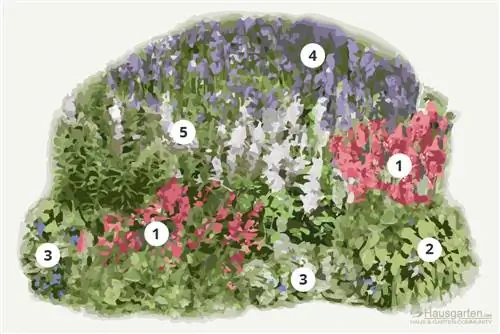
-
Purple Bells (Heuchera)
Growth height 20-50 cm
Flowering period May to July
-
Fairy flower (Epimedium grandiflorum)
Growth height 15-25 cm
Flowering period April to May
-
Caucasus forget-me-not (Brunnera macrophylla)
Growth height 20-30 cm
Flowering period April to June
-
Nettle Bellflower (Campanula trachelium)
Growth height 80-100 cm
Flowering period July to August
-
Magnificent Spiere (Astilbe)
Growth height 60-70 cm
Flowering period July to September
The epitome of the shade bloomer is the unique hosta (Hosta). The flowering perennial impresses with artistic leaf textures and colorful flowers. Thanks to a diverse variety of varieties, there is the ideal hosta for every design wish.
Tip:
The winter-blooming snow rose (Helleborus niger) rounds off any planting plan. The queen of winter flowers sets decorative accents with creamy white cupped flowers from November to February. Thanks to a frost hardiness of up to -40° Celsius, the Christmas rose won't let you down even in the bitter cold.
Design with decorative elements
Decorative elements give flower beds the finishing touch and underline the chosen garden theme. The following design ideas may inspire your imagination for an enviable flower garden:
- Mediterranean garden style: Tuscan lantern, terracotta pots, hand-painted flower pots, pine wood beach chair
- Japanese garden style: Stone lantern, sitting Buddha, stone pagoda, slender stele, moss-covered boulders
- modern garden style: Water feature made of stainless steel, gabions as a bench, raised bed or room divider
A wide range of clever decorations are available to choose from when you create and design a cottage or farm garden with flowers. Seating furniture, raised beds and plant boxes made from Euro pallets, which you can easily build yourself, are popular. Create an original bed with rustic planters from the flea market, such as a zinc tub, washtub, wooden wheelbarrow or milk jug. Look out in the attic for old shoes, old suitcases and similar items that are perfect for a second life as a flower pot.
Start soil preparation the previous year
The implementation of your planting ideas will be a successful project if you devote yourself to preparing the soil in the fall of the previous year. When the planting window opens in April/May, the soil is full of valuable nutrients and busy soil organisms that stimulate growth. How to do it right:
- best time is in September and October
- Dig up the bed area 2 spades deep
- Remove root residues, stones, clods of earth and impurities
- Incorporate 3-5 liters of sifted, mature compost per m² of garden area
- Improve compacted, moist soil with fine-grained quartz sand
- Smooth the soil with a rake and rake
Before you plant and design the flower garden in May, we recommend green manure in March. Seed mixtures, such as Bienenfreund, loosen the soil and ensure a perfect soil climate, which the flowers of your planting ideas will greatly appreciate. Before they reach seed maturity, the green manure plants are mowed down, left as mulch or incorporated into the berry soil using the cultivator.


